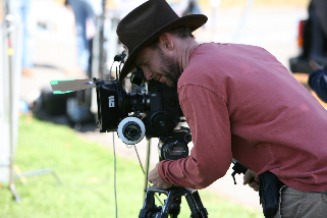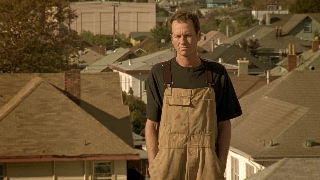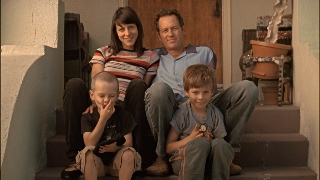by Patrick Ogle
Bradshaw is a director and cinematographer. He has been cinematographer on 35 films and directed/editor five more (three of which he also wrote). His most recent film, Everything Strange and New is a narrative drama that uses both voice-over and music in innovative ways.
“Actually the music was part of the genesis of the film. The shot of the back of the character’s head looking out with cacophonous music is the visual moment that drives the rest of the film.” says Bradshaw.
The music, by Dan Plonsey and Kent Sparling, is a cacophony that stands in direct opposition to the sedate visual imagery. This disconnect is by design and, indeed, is part of Bradshaw’s philosophy of film.
“Music and voice over are things radically misused in films. To me music has to not support the film but offer something new.” he says.
The image and music in that first shot creates something you would not get with just the shot or the music alone. The feeling is expanded by the music. It means something more and something different because of the music. In Bradshaw’s film, and probably in every other film, music can change the relationship between people and landscape. And it does so profoundly.
“Music can change that relationship in a chemical way.” says Bradshaw
Bradshaw uses voice over in a way that is out of the ordinary as well.
“The voice over works much like the music. You never see a character when you hear the voice over. To me, that is the worst thing you can do. If you are seeing someone thinking it becomes false” says Bradshaw. “The voice over is never about what you are looking at.”
Like music he juxtaposes two things do not inherently have a relationship. It expands the movies ‘meaning palette’ he says and allows more interpretation by the audience. And that is a key to this film.
“If I have one goal as a filmmaker it is to open things up to interpretation.” he says.
Whenever he has the opportunity to add or change part of the film the same thought comes to him; “I think about what are the implications for broadening or contracting of the film around the shot.” he says.
His films mean what they mean to you, to me, to anyone who watches, as much as they mean what Bradshaw was thinking while shooting. Indeed, this one thing is ever present in his mind is how to expand possible interpretation rather than restrict it.
If you want to see Everything Strange and New you may have to wait until a DVD release. Its theatrical run has been intermittent.
“It is not in any theaters, or it may or may not be but it is still, in theory, playing theatrically,” says Bradshaw; he then adds a tad of self criticism. “I made a mistake. I made a film about people who do not go to movies. People want to see movies about themselves which is a sad state of affairs.”
You may notice there hasn’t been much plot summary. There is a plot. The film is a “slice of life” about a working man, with two kids and a mortgage working to get by. But it is as much about the audience’s reaction to the life he and his friends lead. It is as much about the somnambulistic way he moves through his life and word and how the good blends with the bad.
The film is also not about what it is about (if that makes sense). And sometimes, we, the audience, like to be told how to feel and know, with certainty what the meaning of a film is. We are not used to being challenged. This film’s aim, and Bradshaw's, is a bit more esoteric.
“It is about the effect of watching the film. It is hard to talk about film as experience rather than a movie,” he says. “I need people to relate to the film in a way they would not normally relate to a movie. Ultimately it is not to tell a story but to give a visceral and emotional experience.”
The film was also shot on Super 16 and feels almost like a series of photographs. The “action” taking place as much in the character’s minds as in the physical action itself. This disembodiment of the characters likely comes from Bradshaw’s background. As a youngster he never thought about becoming a filmmaker. Bradshaw went to art school and became interested in film because he liked reflected light.
“I wasn’t one of those guys who saw Star Wars and wanted to make movies. I wasn’t interested in making films until college.” he says.
Unsurprisingly he wasn’t initially interested in narrative films but rather experimental ones.
“Generally I like to answer my biggest influences are directors I work for as a cinematographer.” says Bradshaw.
When the subject of influences arises he initially talks about various European directors such as Tarkovsky and Bergman. But his real influences come from his job as a cinematographer.
“Generally I like to answer my biggest influences are directors I work for as a cinematographer.” says Bradshaw.
He gets to see these directors succeed and fail, sometimes on a grand scale. They make his mistakes for him. Most directors do not have the benefit of such experience. Bradshaw learns what he doesn’t want to do as much as what he does.
“There is inherent risk in making a good film.” he says.
But he gets to take risks that are “less risky” because he has witnessed other directors making similar decisions.
As to what is next Bradshaw is writing something and is working on what he refers to as a “straight forward documentary project”.
Bradshaw was also cinematographer on the film, Babies. Whenever this film is mentioned to the cynical film snob they think it is about Anne Gedde. It is, in fact, more like a BBC nature film. He is also credited with being an “additional photographer” on the documentary about Townes Van Zant, Be Here to Love Me. He says (and makes a compelling case) that a “director of photography” credit would have been more appropriate. There was a break in filming and after that, there was a new director of photography.
“I made $93 a day as a favor to Margaret (Brown),” he says. “After six weeks we ran out of money. I went home. Margaret started dating Lee Daniel and when they started shooting again. Well, you can’t beat free boyfriend labor.”
And if you are into innovative, thoughtful filmmaking you cannot beat Everything Strange and New.



 RSS Feed
RSS Feed